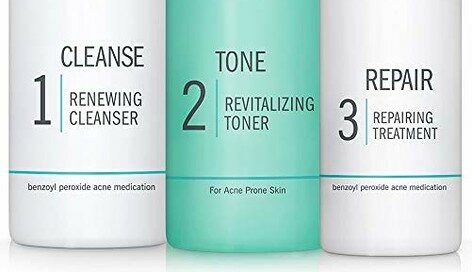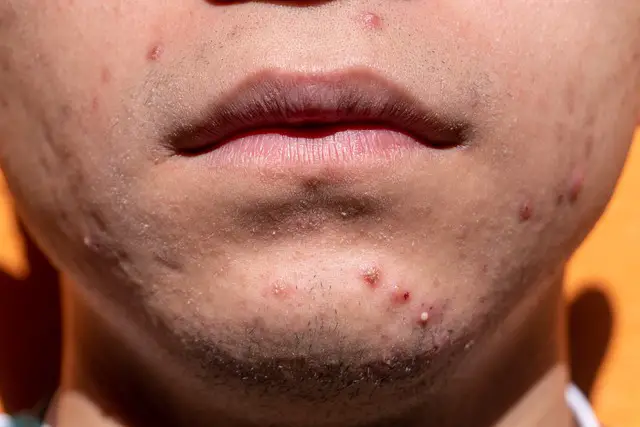Both benzoyl peroxide and salicylic acid are effective treatments for acne. Benzoyl peroxide is more effective in treating inflammatory acne while salicylic acid is better suited for non-inflammatory acne. It’s also important to note that both products can cause dryness and irritation if not used correctly.
Benzoyl Peroxide
(Photo By eko sunaryo on Flickr)

Benzoyl peroxide is a popular acne-fighting ingredient that has been around for decades. It works by killing the bacteria that causes acne and reducing inflammation in the skin. Benzoyl peroxide comes in different strengths, ranging from 2.5% to 10%, and it’s available in many forms such as cleansers, creams, gels, and spot treatments.
One of the advantages of benzoyl peroxide is its fast-acting nature. It can start working within days of use and often shows visible results within weeks. However, it can also be quite drying on the skin which makes moisturizing essential when using this ingredient regularly.
It’s important to note that benzoyl peroxide can bleach clothing, towels or sheets so be mindful when applying it before bedtime or getting dressed after application.
Benzoyl peroxide may not work for everyone – some people may experience side effects such as redness or irritation while others might find their breakouts worsen instead of improving over time. If you’re unsure whether benzoyl peroxide is right for your skin type, consult with a dermatologist beforehand!
Salicylic Acid
Salicylic acid is a popular ingredient in many acne-fighting products. It’s known for its ability to penetrate deep into the pores, breaking down dirt and oil that causes breakouts. Salicylic acid is derived from willow bark, and it’s often used in combination with other acne treatments.
One of the benefits of salicylic acid is that it exfoliates the skin. This means it can help remove dead skin cells and unclog pores, leading to clearer skin. It also has anti-inflammatory properties which can reduce redness and swelling associated with acne.
However, like any skincare ingredient, there are potential downsides to using salicylic acid. For one thing, it can be drying if overused or applied too frequently. Additionally, some people may experience irritation or allergic reactions when using products containing salicylic acid.
Salicylic acid can be an effective tool in fighting acne-prone skin when used properly as part of a well-rounded skincare routine.
Benzoyl peroxide Vs. Salicylic acid – Key differences
When it comes to treating acne, benzoyl peroxide and salicylic acid are two of the most popular ingredients found in over-the-counter products. While they both work towards preventing and reducing acne breakouts, there are some key differences between these two powerhouse ingredients.
Benzoyl peroxide is an antibacterial agent that works by killing bacteria on the skin’s surface. It also helps to unclog pores by removing dead skin cells and excess oil. On the other hand, salicylic acid is a beta-hydroxy acid that exfoliates the skin from within the pore, helping to clear out dirt and debris.
One major difference between benzoyl peroxide and salicylic acid is their effectiveness against different types of acne. Benzoyl peroxide tends to be more effective at treating inflammatory acne (pimples with redness), while salicylic acid is better suited for non-inflammatory acne (blackheads and whiteheads).
Another important distinction between these two ingredients lies in their potential side effects. Benzoyl peroxide can be quite drying on the skin, leading to flakiness or peeling if not used correctly. Salicylic acid may cause dryness as well but tends to be gentler overall.
Ultimately, when choosing between benzoyl peroxide and salicylic acid for your skincare routine, it’s essential to consider your individual needs based on your specific type of acne or breakout-prone areas.
Which is better – benzoyl peroxide or salicylic acid?
(Image by Ortega Ulloa from Pixabay )

If you have mild to moderate acne, salicylic acid may be a better option as it is gentler on the skin than benzoyl peroxide. Salicylic acid also has anti-inflammatory properties that can help reduce redness and swelling associated with acne breakouts.
However, if you have severe or cystic acne, benzoyl peroxide may be more effective as it targets the root cause of acne – bacteria. It also helps prevent future breakouts by keeping pores clear of excess oil and sebum.
It’s important to note that both benzoyl peroxide and salicylic acid can cause dryness or irritation when used in high concentrations or too frequently. It’s best to start with a low concentration product and gradually increase over time if needed.
Ultimately, choosing between benzoyl peroxide or salicylic acid comes down to personal preference based on your individual skin type and specific skincare needs.
How to use Benzoyl Peroxide and Salicylic Acid for acne?
When using benzoyl peroxide, start with a small amount and gradually increase over time as your skin adjusts. Apply it evenly all over the affected area or just on individual pimples if preferred. It’s recommended to use once a day at first and then work up to twice daily if needed.
Salicylic acid can also be applied directly onto the affected areas of skin but is usually milder than benzoyl peroxide. Use sparingly as directed on the packaging, typically one application in the morning and one in the evening.
It’s essential not to mix these two products together since they could cause irritation or even chemical reactions that exacerbate acne instead of treating it. Alternatively, you can alternate days when using them so that you’re not applying too many active ingredients at once.
Remember always do a patch test before trying any new skincare treatment because everyone’s skin reacts differently!
The advantages and disadvantages of benzoyl peroxide and salicylic acid
Benzoyl peroxide and salicylic acid are two of the most popular acne treatments available over the counter. They work differently, and each has its advantages and disadvantages.
Advantages of Benzoyl Peroxide:
- Kills bacteria: Benzoyl peroxide is effective at killing the bacteria that cause acne, reducing the likelihood of future breakouts.
- Exfoliates: Benzoyl peroxide helps to exfoliate the skin, which can improve the texture and appearance of the skin.
- Works quickly: Benzoyl peroxide can start working within a few days of use, making it a popular choice for those who want quick results.
Disadvantages of Benzoyl Peroxide:
- Dryness: Benzoyl peroxide can be very drying to the skin, leading to flakiness, redness, and irritation.
- Bleaching: Benzoyl peroxide can bleach clothing and towels, so it’s important to be careful when using it.
- Not suitable for everyone: Benzoyl peroxide can be harsh on sensitive skin, and some people may experience an allergic reaction to it.
Advantages of Salicylic Acid:
- Exfoliates: Salicylic acid helps to exfoliate the skin, removing dead skin cells and unclogging pores.
- Reduces inflammation: Salicylic acid has anti-inflammatory properties, which can help to reduce the redness and swelling associated with acne.
- Gentle: Salicylic acid is gentler on the skin than benzoyl peroxide, making it a better choice for those with sensitive skin.
Disadvantages of Salicylic Acid:
- Slow acting: Salicylic acid may take longer to show results than benzoyl peroxide.
- Less effective against bacteria: Salicylic acid is not as effective at killing acne-causing bacteria as benzoyl peroxide.
- Can cause dryness: Salicylic acid can also cause dryness and irritation, particularly when used in high concentrations or in combination with other acne treatments.









